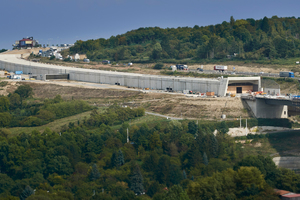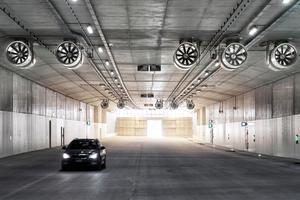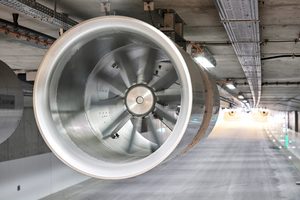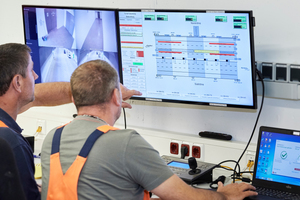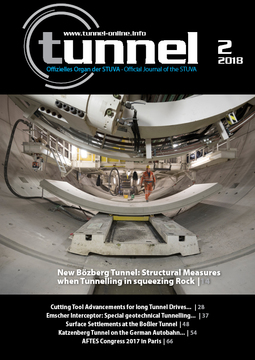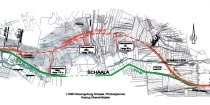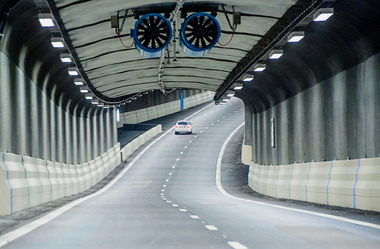Katzenbergtunnel on the Autobahn A3: Fire Protection in the North Tunnel with 25 Axial Fans
The 570 m long Katzenberg Tunnel on the German Autobahn A3 near Würzburg is currently under construction by cut-and-cover with a total investment volume of about 44 million euros. The first construction section, the north tunnel, went into operation on 1 March 2018 and is equipped with a mechanical longitudinal ventilation system. Arranged in groups of five with one set as reserve (stored in the Autobahn office in Kist), Systemair jet fans are used in case of fire to extract smoke on one side of the fire toward the exit portal. Tunnel users are thus protected against the effects of smoke and heat and the traffic space will be kept free of smoke.
The federal Autobahn A3 is one of the most heavily trafficked routes in Germany with about 95 000 vehicles travelling north and south every day, about half of which are heavy goods vehicles. In consideration of this, the state of Bavaria has categorised the new construction of the 570 m long Katzenberg Tunnel near Würzburg as one of the first projects in the category „critical infrastructure“. Because when traffic no longer flows on the A3 due to a problem in the tunnel, then all the traffic in the neighbourhood breaks down, especially in Würzburg itself – with catastrophic consequences for fire service interventions or rescue in case of an incident.
Ventilation and Extraction with Jet Fans
The design of the installed technical safety system is correspondingly
differentiated and comprehensive; particularly the ventilation and extraction of the north tunnel with jet fans. Because in addition to the possibly long maintenance of function of the tunnel ventilation in case of a fire (at least 90 minutes), the constructional restraints in this tunnel were a particular problem. The north tunnel with a clear width of 19 to 22 m and four lanes has two curves like a slow S, and the length of 570 m also has a downward gradient of 3.95 % toward the western exit portal. Natural air exchange from the sometimes massive wind pressure from the valley at the western tunnel exit does not work in case of fire. In practice, this largely constant west wind can even be completely negated by the air pressure created by traffic in the tunnel.
Laborious Calculations for the Ventilation
Design in Advance
In order to cope with these dynamic pressure conditions, the tunnel is equipped with 25 Systemair axial fans of type AJ 1000 TR, each with a power of 30 kW. A further fan is available as a reserve. The fans are also mounted under the tunnel roof in such a way that a fan can be added to each group in case of high ventilation demand. The entire redundantly designed SPS control system for the fans is already prepared in the switching cabinets in the tunnel walls and in the control centre of the tunnel system. The same applies for the cabling integrated in the concrete.
The ventilation system designed by HBI Haerter (Heidenheim, Germany) as the responsible ventilation consultant and by GBI Gackstatter Beratende Ingenieure (Stuttgart, Germany) is designed so that the axial fans in the tunnel, which normally carries traffic in one direction, are switched in sections with a defined smoke extraction direction and thus expel the smoke produced by a fire in the travel direction, into the part of the tunnel without traffic. The achieved velocity is fast enough to be able to securely expel the smoke to one side and thus ensure the maintenance of visibility and freedom from smoke in the part of the tunnel occupied by people and vehicles travelling toward the fire – an essential precondition for the rapid and most complete possible evacuation of the tunnel after an incident.
The calculations performed by HBI in advance of the design work were also confirmed in practice with a practical performance verification of a jet fan on the test rig of Systemair in Windischbuch. A practical smoke test on site in the presence of the fire service and the responsible authorities once more confirmed the performance shown theoretically and on the test rig.
Fans should remain operative for more
than two Hours
in Case of Fire
All the fans installed in the A3 tunnel at Würzburg are also designed to be reversible, still with a degree of effectiveness of almost 22 m³ per second, about 10 % less than the performance in normal operation. GBI project engineer Matthias Falck: „the installed performance is thus designed to be sufficient according to the RABT guideline so that even in a meteorologically exceptional situation with permanent wind pressure on the east portal at the same time as a fire incident in the tunnel, the smoke load can be extracted without problems toward the valley.“
In any case, functional security is ensured thanks to the temperature resistance of 400 °C of the stainless steel axial fans over the specified period of at least 90 minutes. In practice, an actual operating time of two hours and more can be assumed, since the peak temperatures at the fan in case of a fire normally arise with a time delay. Achim Wöhrle, Key Account Manager at Systemair: „We normally assume at least 120 minutes for this type of fan, having confirmed this in tests.“
Material-saving Control System
In normal operation, the fans installed in the Würzburg tunnel are switched off; the necessary air exchange for the ventilation demand is supplied by the natural incoming west wind. This also ensures almost permanent slight rotation of the fans to save them from becoming stuck.
In case of a fire, the fans are put into operation by an intelligent control system, which like the overall concept of this tunnel installation was designed and implemented to the last switch cabinet terminal by OSMO Anlagenbau from Georgsmarienhütte (Germany). When the fire detection system initiates an alarm, the fans in the affected fire section are smoothly run up, taking into account the values measured for the natural air flow. For this purpose, each fan is equipped with its own frequency converter, which sets the appropriate revolution speed for the demand. Achim Wöhrle: „this treats the fan technology gently and also pays off in longer maintenance of function in case of a fire.“
Saving of material was also the idea behind the relatively elaborate roof mounting of the jet fans. Due to the longitudinal gradient and transverse fall of the tunnel tube, the loads on the fans in operating condition are also above average, which in this case was dealt with by additional mounting frames with buffers for uniform load distribution.
Fire Detection
Various fire detection systems are installed. Linear heat detectors, for example, record temperature changes in the tunnel and optical sensors measure the particle content in the air, so that „any fire will be detected in less than 60 seconds“, is how Matthias Falck describes the safety concept. This short activation time should normally be improved still further since incidents preceding a fire will be recorded and automatically evaluated by the optical sensors of the video cameras installed in the entire tunnel. The four stored images for this purpose are persons on the carriageway or the emergency pavements, smoke, falling loads and tailbacks.
Redundant Electricity Supply
Maintenance of the function of the smoke extraction system in the new road tunnel understandably depends not just on the fans and their performance or their interaction but at least as much on a reliable electricity supply. Altogether more than 24 t of cable was required for each fan, plus control cables, to ensure this.
In order to cover the electricity demand of the tunnels, a medium voltage switch plant with two dry transformers each 1000 kVA has been installed. For emergency power supply, a 300 kVA diesel generator will be available from 2019. If the power nevertheless fails, a 200 kVA uninterruptible power supply (UPS) will ensure at least a further hour of operation of the fire detection system, the safety lighting and the digital operational radio system.
Subsequent Installation possible
for the South tunnel
After the opening of the north Katzenberg Tunnel, now follows the construction of the south tunnel. During this second construction phase, the north tunnel will be operated with two-way traffic, three lanes in the direction of Frankfurt and two toward Nuremberg.
The second tunnel is indeed being constructed with comparable safety equipment but – initially – without mechanical ventilation. Matthias Falck: „calculations show that the natural air flow from the west is sufficient to keep the south tunnel, which climbs to the east, free of smoke in the event of a fire, above all because the uphill gradient of the tunnel and the traffic flow are in the same direction.“
Should it however turn out after completion of the second tunnel that these natural flow dynamics do not function as assumed, five groups of five Systemair axial fans can also be installed here without problems: the necessary fixing points for these including cabling have already been planned as a precaution.
The completed north tunnel will house four lanes each 3.50 m wide, and the south tunnel will have three lanes. Each tunnel also has an escape pavement 1 m wide at each side. The clear height is more than 6.20 m throughout.
Completion of the overall construction project is planned for 2019, after which both tunnels will be covered with several metres of earth.

